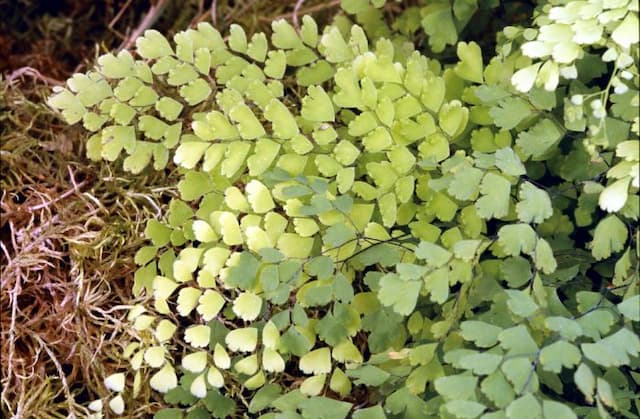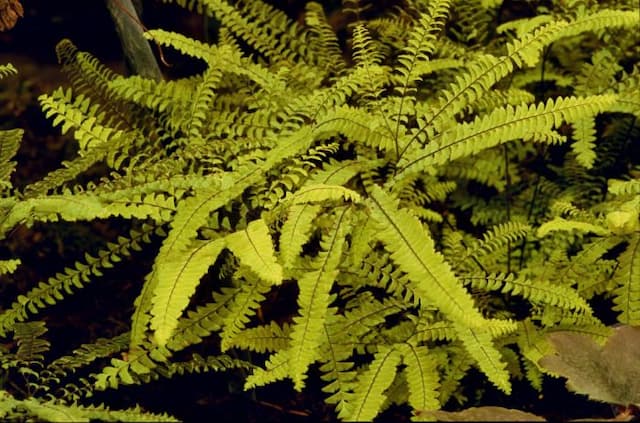Golden Variegated Japanese Holly Fern Coniogramme japonica 'Flavomaculata'

ABOUT
The plant commonly known as the Golden Variegated Japanese Bamboo Fern features an attractive foliage that is distinguished by its broad, elegant fronds with a unique visual appeal. The leaves are a deep green with irregular, bright yellow splashes that give the fronds a speckled look. This variegation pattern across the leaves creates a striking contrast, which makes this plant a visually appealing and decorative choice for gardens or indoor spaces. The leaflets, which are arranged neatly along the central stalk of each frond, have smooth edges and a slightly shiny surface, underscoring the plant's lush appearance. Its overall visual effect is one of tropical elegance and brightness, adding a refreshing splash of color to the areas where it grows. The Golden Variegated Japanese Bamboo Fern, while named for its bamboo-like appearance, is indeed a fern and not a true bamboo.
About this plant
 Names
NamesFamily
Pteridaceae.
Synonyms
Golden Variegated Japanese Brake Fern, Yellow-Spotted Bamboo Fern.
Common names
Coniogramme japonica 'Flavomaculata'.
 Toxicity
ToxicityTo humans
The Bamboo Fern (Coniogramme japonica 'Flavomaculata') is not known to be toxic to humans. Therefore, ingesting this plant should not result in poisoning or adverse health effects specific to its toxicity.
To pets
The Bamboo Fern (Coniogramme japonica 'Flavomaculata') is also not known to be toxic to pets. Ingesting this plant should not cause any toxic effects or poisoning in animals such as cats and dogs.
 Characteristics
CharacteristicsLife cycle
Perennials
Foliage type
Evergreen
Color of leaves
Mixed
Height
2 feet (60 cm)
Spread
2 feet (60 cm)
Plant type
Fern
Hardiness zones
7
Native area
Japan
Benefits
 General Benefits
General Benefits- Ornamental Value: The plant offers aesthetic appeal with its distinct yellow variegation on the leaves, which can add contrast and visual interest to shade gardens.
- Shade Tolerance: It thrives in shaded environments where other plants may struggle, making it an ideal choice for understory plantings.
- Low Maintenance: This fern requires minimal care once established, making it a convenient choice for gardeners with limited time.
- Drought Resistance: Once established, it can tolerate periods of dryness, reducing the need for frequent watering.
- Soil Versatility: Coniogramme japonica 'Flavomaculata' can adapt to a variety of soil conditions, though it prefers moist, well-drained soil.
- Deer Resistance: It is generally resistant to deer, which makes it a practical choice in areas where deer browsing is a common problem.
- Ground Cover: This fern can serve as an effective ground cover, helping to suppress weeds and minimize soil erosion in shaded areas.
- Long-Lived: As a perennial, it can live for many years, providing long-term interest in the garden without the need for replanting annually.
 Medical Properties
Medical PropertiesThis plant is not used for medical purposes.
 Air-purifying Qualities
Air-purifying QualitiesThis plant is not specifically known for air purifying qualities.
 Other Uses
Other Uses- Artistic inspiration: Bamboo Fern's striking leaf patterns can inspire graphic designers, artists, and photographers, encouraging them to incorporate the unique aesthetic into their work.
- Natural dye: Some enthusiasts experiment with using the distinctively colored fronds of Bamboo Fern as a natural dye for fabrics, offering a source of organic coloration.
- Educational tool: This plant can be used for botanical studies, helping students learn about pteridophyte life cycles and the diversity of fern species.
- Container planting: Bamboo Fern is suitable for container planting, allowing gardeners to create dynamic arrangements in pots or on terraces where soil planting is not an option.
- Biotope aquariums: Aquarists might use this fern to simulate a natural forest biotope aquarium, providing a lush, green backdrop that caters to the needs of certain fish.
- Plant propagation: Horticulture enthusiasts can use Bamboo Fern to practice propagation techniques with ferns, such as division or spore cultivation.
- Erosion control: When planted on slopes or areas prone to erosion, Bamboo Fern can help stabilize the soil with its root system, though it's not its primary use.
- Shade garden enhancement: This fern can be used to beautify and add textural contrasts within a shade garden, which can be a challenging environment for other plants.
- Religious and cultural symbolism: In some cultures, ferns like Bamboo Fern may carry symbolic significance and could be included in cultural rituals or garden designs that reflect traditional values.
- Photography subject: The unique appearance of Bamboo Fern makes it an interesting subject for photographers specializing in botany or macro photography.
Interesting Facts
 Feng Shui
Feng ShuiThe Japanese Painted Fern is not used in Feng Shui practice.
 Zodiac Sign Compitability
Zodiac Sign CompitabilityThe Japanese Painted Fern is not used in astrology practice.
 Plant Symbolism
Plant Symbolism- Resilience: Coniogramme japonica 'Flavomaculata', commonly known as the Golden Bamboo Fern, often symbolizes resilience because it can thrive in various conditions, similar to how bamboo is known for its hardiness.
- Elegance: With its striking variegated fronds and graceful growth pattern, this plant is associated with elegance and beauty, harkening to the sophisticated aesthetic often found in Japanese gardens.
- Growth: Just as the fern grows by unfurling its fronds, it is commonly understood to represent new growth, personal development, and the unfolding of hidden potential.
- Endurance: Given the fern's ability to persist and adapt through different climates and soils, it can serve as a symbol of endurance through challenging times.
- Secretiveness: Historically, ferns have been tied to themes of secretiveness and hidden lore, due to their dwelling in dense forests and the cryptic nature of their reproductive spores.
 Water
WaterThe Japanese Painted Fern should be watered thoroughly, allowing the soil to become slightly dry between waterings; this typically means watering once every 7 to 10 days depending on environmental conditions. When watering, use room temperature water and aim for about 1 inch of water to ensure that the moisture reaches the root zone. Provide enough water to moisten the soil without leaving the plant standing in water, as this can cause root rot. During the growing season in spring and summer, the fern may require more frequent waterings, while in winter, reduce the frequency as the plant enters dormancy.
 Light
LightThe Japanese Painted Fern thrives in moderate to bright indirect light, but it can also tolerate low light conditions. It’s best to place the fern in a spot where it receives filtered sunlight, such as near a north-facing window or under the canopy of taller plants. Direct sunlight can scorch its leaves, so it’s important to avoid placing it in direct sun exposure.
 Temperature
TemperatureThe Japanese Painted Fern prefers a temperature range between 60 to 75 degrees Fahrenheit; however, it can tolerate temperatures as low as 50 degrees and as high as 80 degrees Fahrenheit. For optimal growth, maintain a consistent temperature without sudden fluctuations and protect the fern from cold drafts and hot air vents.
 Pruning
PruningPruning the Japanese Painted Fern is generally done to remove dead or yellowing fronds and to maintain its appearance. It's best to prune in the early spring before new growth begins, cutting back any old fronds to make way for fresh ones. This fern does not require heavy pruning; simply tidy it up as needed.
 Cleaning
CleaningAs needed
 Soil
SoilJapanese Painted Fern thrives in a well-draining, humus-rich mix with a pH around 5.5 to 6.5. A mix of one part peat moss, one part garden soil, and one part perlite or coarse sand is ideal for this shade-loving fern.
 Repotting
RepottingThe Japanese Painted Fern should be repotted every 2-3 years or when it becomes root-bound. Repotting helps to refresh the soil and provides room for growth.
 Humidity & Misting
Humidity & MistingThe Japanese Painted Fern prefers high humidity levels, ideally between 60% and 80%. Maintaining this range will support its lush foliage.
 Suitable locations
Suitable locationsIndoor
Place in shade, keep soil moist, high humidity.
Outdoor
Shade, humus-rich soil, protect from wind.
Hardiness zone
5-8 USDA
 Life cycle
Life cycleConiogramme japonica 'Flavomaculata', commonly known as the Bamboo Fern, starts its life cycle from spores, rather than seeds, which upon finding suitable moist conditions, germinate to produce a gametophyte. The gametophyte is a small, heart-shaped structure that houses the reproductive organs, which, upon fertilization, grow into a new sporophyte fern. This young sporophyte, the fern as we recognize it, begins as a fiddlehead, which is a tightly coiled new frond that unfurls as it matures. As the fiddlehead expands, the characteristic yellow-spotted fronds of the Bamboo Fern develop, which are then capable of photosynthesis, contributing to the growth and energy needs of the fern. Mature ferns will eventually produce spores on the underside of their fronds, housed in structures called sori. These spores are released into the environment to propagate new gametophytes, completing the life cycle of the plant.
 Propogation
PropogationPropogation time
Spring-Early Summer
Coniogramme japonica 'Flavomaculata', commonly known as the Japanese bamboo fern, is typically propagated through division, which is a popular method for many fern species. This propagation method is best done in the spring season when the plant is emerging from dormancy and active growth begins. To propagate by division, the parent plant should be carefully lifted from the soil to minimize root damage. Once out of the ground, the root ball can be divided into smaller sections, each with several fronds and a healthy portion of the root system. These divisions can then be potted up in individual containers filled with a well-draining potting mix or planted directly into the ground in a shaded area. It's important to keep the newly divided plants moist and out of direct sunlight until they establish in their new locations.




